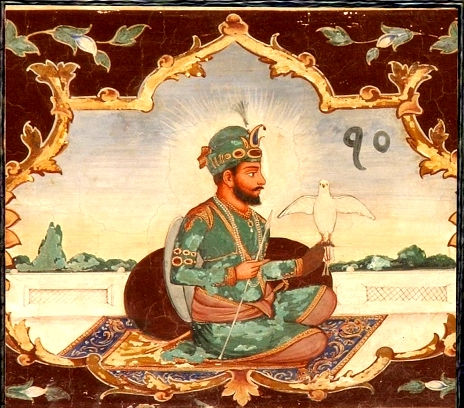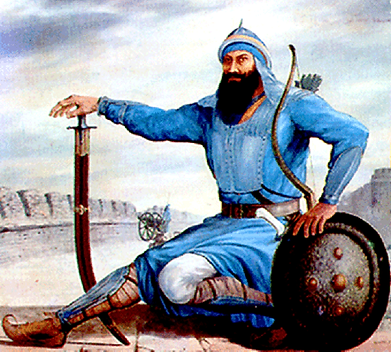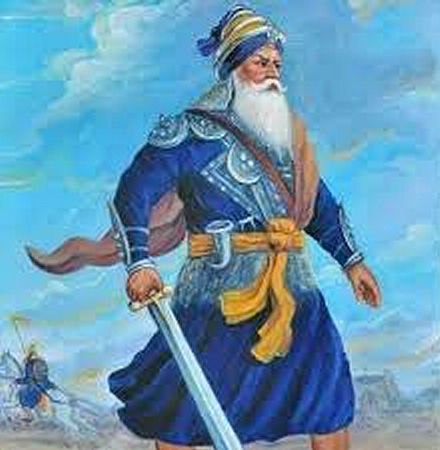Development and training of the Khalsa

Guru Gobind Singh Ji was first and foremost the spiritual leader of the Sikhs, but here we analyse Guru Gobind Singh Ji’s role as a military commander.
Guru Gobind Singh Ji had realised from his childhood that war has ceased to be a pursuit of regular professional armies. Guru Ji knew that one cannot realise oneself if he is without strength and fortitude, hence there was a definite need of raising the whole community fit for combat where each individual, in addition to leading himself or a body of troops into battle, has also to function as a leader of the community. Therefore, in addition to military virtues of soldiers based upon very sound moral, ethical code, each individual was to be trained to understand the society in which he lived in, nationalism, flexibility of mind and spiritual advancement.
Guru Sahib Ji considered the best soldiers were those who were physically strong, mentally and morally sound and also who were ready to lay down their lives smilingly without hesitation or second thought. Guru Ji instilled in them that war was for the privileged and martyrdom in combat the ultimate honour. The culmination of this was when Guru Gobind Singh Ji staged a most extraordinary feat on Vaisakhi 1699 in order to create the nucleus of his army by creating the Panj Piyaray and the Khalsa panth.
The myth of martial and non-martial races need not be given much credence as three of his baptised Panj Pyairay were from low and untouchable classes of society. Guru Sahib Ji slashed down the age old traditions of society that war was the prerogative of the Kahatris alone. Any one, who was sincere, puritan by heart could be a soldier in the Guru’s army. To Guru Gobind Singh Ji all races could fight equally well if and when provided with a just cause and good leadership.
The leader and the led where like a hand in a glove. Both fight a common enemy with a single mission – either victory or martyrdom. Irrespective of their ranks and status both leader and led in the Gurus army sat and ate together.

Physical Training.
Physical training was given utmost importance because Guru Gobind Singh Ji had realised that a robust body is essential not only to fit the man for the rigours of soldiering but also to bring about alertness of mind and coordination which , along with physical fitness results in true mobility. The following methods were employed to promote physical fitness :-
1. Martial games and physical exercises were conduced regularly. These involved physical conditioning and toughening of the troops. These were followed by test exercises at the times of Holi or Mahalla festivals. Prizes were given to the most able bodied.
2. Healthy sports like athletics, wrestling, riding, tent pegging etc were organised on competitive regular basis.
3. Balanced and regular day-to-day routine of his soldiers in a way ensured physical conditioning of his soldiers.
4. The army was made to drill. Guru Sahib Ji had invented a form of drill suited to his men and the times. It helped improve the general discipline of recruits.

Weapons Training.
1. Guru Gobind Singh Ji through his compositions (Shastar Naam Mala Puran) has candidly projected the personified the concept that weapons were the medium of worshipping God. The following methods were employed to train the Sikhs.
2. Five hundred pathan soldiers from the Mughal army were employed to teach the art of warfare and the use of different weapons.
3. Regular competitions in archery, sword fighting, hand to hand combat, and rewards prompted a healthy spirit and better standards.
4. Large scale hunting expeditions were organised where soldiers obtained training to use their weapons on live and fast moving targets. The ranges around Paonta Sahib were full of deer and wild boar known for their swiftness and agility. Also, the expeditions lasted many days during which the soldiers were trained to live off the land with an aim to toughen them and acquaint them with battle-like stress and strains.
5. Very high standards in weapons training were set. Soldiers were trained to shoot to kill between 500 to 1000 yard range.

Tactical Training.
1. Although tactical training were basic compared to present day warfare, but the importance of mobility in battlefield and utilisation of terrain to the best advantage had been highlighted by Guru Sahib Ji.
2. Acquisition of Arabian horses which were known for their speed, swiftness and grace.
3. Organised mock battles and military exercises for the defence of Anandpur. The common mock fights were in the form of two groups, one in charge of an enclave , the other with the aim to capture it. There were a number of mock fights and counter attacks until the fort was stormed and captured.
4. In order to increase mobility and flexibility on the battle field the ratio of cavalry to foot infantry was increased by 100 percent then what the Mughal armies maintained.
5. The cavalry were trained to launch lightning attacks to shock the enemy followed by foot infantry, which exploited the demoralised the enemy to the best resultant advantage.
6. Gunners were trained to use their artillery for the protection of strategic points of the forts. When the gunners pounded an enemy concentrated in front of the gates of the fort, the mounted cavalry were then let loose upon them , while the foot infantry launched attacks from different directions. These tactics are analogous to the fire and move tactics practiced today.
The Moral Code
Guru Gobind Singh Ji realised that sound morals and a strong character was the strongest defence of his soldiers for the war of righteousness. To this end he trained his men unabated.
1. His Khalsa shall always bow collectively to the will of an assembly of five Sikhs, thus Guru Ji separated politics from the soldier and brought him under the direct fold of democracy.
2. His Khalsa shall not injure women, children and the aged. He shall always be ready to save the honour of all women (and that included those of the enemy)
3. His Khalsa was forbidden to touch a turk woman. On the face of it this may seem a little extreme, but Guru Sahib Ji’s high moral code for his Khalsa meant that no retaliation was possible against women no matter how heinous the enemy crimes were against the indigenous population.
4. His Khalsa shall not seek help of any form from way layers or thugs in the furtherance of Dharma Yudha.
5. His Khalsa shall not attack such soldiers who were without arms or had surrendered or on their heels in the battle field.
6. His Khalsa shall not plunder the lawful belongings of others.
7. His Khalsa will never insult a guest in his home. Instead, safety of life and property would be considered as the highest form of religion.
8. His Khalsa shall attend to the wounded in battle and perform the last rites for his own and the enemies dead. *
9. His Khalsa shall lead a pure Grihasth (family life) and practice temperance in all sphere of married life.
It is a little known fact that Sikhs used to tend to their own battle injured, but more importantly that of the enemy. They would bring them back to base camp, caring and tending to their wounds and nursing them back to health. They were fed and kept safe ,once they were well enough Guru Gobind Singh Ji would ask his Sikhs to bring the enemy soldiers their horse, weapons and belongings. Guru Ji would tell them "Now go and we shall meet you again on the battlefield." For Guru ji there was no enemy, there was no foe, all were the same and Guru Ji looked upon everyone with the same benevelant gaze.
Many enemy soldiers would leave with tears in their eyes, laying down their weapons they would say "How can we fight him who is Khudha?"
Guru Gobind Singh Ji created an administrative body for his army. The administrative commanders were the most efficient and trusted sons of his father’s late sister. They were Jit Mall, Gopal Chand, Sangho Shah and Mohri Chand, who were made in change of civil defence problems at Anandpur, weapons and ammunitions, war animals and food and supplies.
They were given the name Singh (lion) which even today is a basic factor to prove the universal brotherhood of the Khalsa; a pure soldier fighting for the cause of righteousness against tyranny and injustice in the name of Dharama.
Guru Ji symbolised war as Dharam Yudh which was a war of righteousness in which, participants were proclaimed as God’s warriors, fighting battles under God’s protection and gained victories in His name.
The sword became a substitute for the rosary with which God was to be saluted and worshipped. It was to strike terror into the hearts of the oppressor and infuse courage and confidence in the hearts of his Khalsa soldiers.
At this occasion Guru Ji blessed the Khalsa with the battle cry of “Bole so nihal Sat siri Akaal” – The one who believes in the truth of God is immortal; which ever has been shouted has unnerved and nonplussed the enemy in the battle field. In the eyes of General Wavell “Never met a despondent Sikh in the front line, in a hospital, in the rear, he may moan over a small wound but in a fight, he will go on to his last breath and die laughing at the thought of paradise with the battle cry of Bole so nihal Sat siri Akaal as he falls.”
To begin with, one out of four Sikhs in a family was required to enlist as a regular soldier in the Guru’s army. If a family found it difficult to spare a member, it then bore the expense of employing a soldier. This had to be resorted to because the common masses dreaded the very thought of fighting the Mughals who had established themselves in all spheres of life. But gradually the people began to realise that in order to alleviate their sufferings, despondency and frustration a third community under the leadership of Guru Gobind Singh Ji was the only solution.
Within a short time, in response to Guru Ji’s call, large bands of Sikhs from the villages far and near Anandpur Sahib volunteered to join Guru Ji’s army. In fact Guru Ji’s message was so deep rooted and strong that Sikh boys, before they learnt to tie their turbans learnt the use of arms, and white bearded men wanted to join up. The Khalsa was fed on the divine words of chivalry and fearlessness.
Psychology
Guru Gobind Singh Ji had realised that equally important to the knowledge of use of arms and weapons for the success of his programme was the building up of the right type of psyche in the minds of the soldier. Therefore certain methods were used to psychologically prepare every Sikh fit for war :
1.Although the term Sikh had started in the times of Guru Nanak Dev Ji, everyone in the community was called a Sikh, one who has had Sikhia or learning. Thus each individual by virtue of his association with the community was to consider himself Guru’s soldier.
2.The name of Singh was given to each individual to remind him of all times to be brave, nimble and powerful as a lion, ladies were given the name of Kaur.
3.Names were to be set on terms of valour, bravery, victory and heroism. Exemplary in this regard are the name of Guru ji’s sons : Ajit Singh – Invincible lion, Jujhar Singh - Lion expert in hand to hand combat, Zorawar Singh – powerful lion and Fateh Singh – victorious lion.
4. Each soldier was considered equivalent to one and a quarter lakh soldiers – sava lakh. It was the psychological training which was meant to enable a soldier to be mentally prepared to face a vastly superior in numbers enemy.
5. Old scriptures confirm that strength and vigour received by the human body from food gives impetus to the same thought process which the person had while eating his food and consequently moulds the actions of the man consciously and unconsciously. Therefore, Guru Gobind Singh Ji’s war drum, known as Ranjit Nagara, was sounded unabated while his soldiers had their food in the langar.
6. Guru Sahib Ji issued hukams/orders forbidding all and sundry from giving Jayziya (a tax levied by Aurangzeb on non –muslims) , bowing to the muslims with folded hands and assisting the agents of the emperor in realising jaziya. So for the new community Guru Ji changed the old ideal of humility and surrender into a new one of self assertion and self reliance. The aim partly being that his soldiers did not undergo such psychological human subjugation under any Moghals.
7. Each individual was characterised by the possession of Kesh, Kanga, Kara, Kuchha and Kirpan at all times, to remind him that without these he was incomplete and to bring war like change to his entire attitude and personality. The five items all had military bearing and significance and were designed to give uniformity to the Khalsa in character.
8. Guru Ji infused the idea in his Sikhs that fear from any mortal was a myth and to be fearless in combat is God’s rare virtue, which every Sikh must possess in order to be near Him. Thus Guru Ji twined religion with sacrifice and martyrdom.
9. In Asa-di-vaar, an integral part of the prayer itself is a vow which every Sikh took religiously every morning. This reminded him that his sole mission in life was to do or die at the command of his leader, Guru Gobind Singh.
10. Guru Ji gave blue colour to the uniform of the Khalsa army which was symbolic then to only the contemporary Moghal forces in order to defy the Moghals from the very beginning.
11. Symbolised victory through every salutation ie Waheguru Ji Ka Khalsa Waheguru Ji Ki Fateh to that the concept of impersonal victory grows deep in the psyche of every individual at all levels of society. It was a revolutionary sociopolitical- religious thought given to the masses for the first time in the history of India. The concept of impersonal victory basically ensured that his Khalsa never became complacent about his success and remained away from the deadly clutches of vanity and pride.